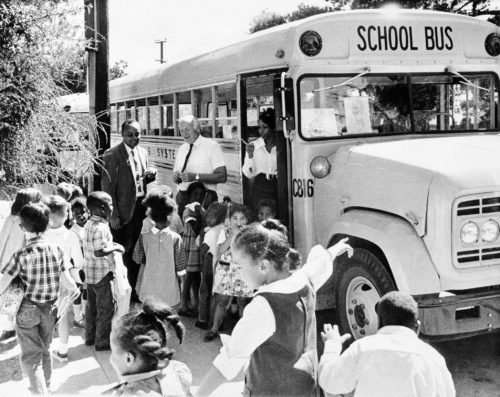Kamala Harris and Classmates Were Bused Across Berkeley.
Share
Explore Our Galleries
Breaking News!
Today's news and culture by Black and other reporters in the Black and mainstream media.
Ways to Support ABHM?
By Nellie Bowles, The New York Times
In 1967, the superintendent of the Berkeley, Calif., school district had resolved to desegregate the city schools. “We will set an example for all the cities of America,” he wrote in a report called “Integration: A Plan for Berkeley,” which he presented to the Berkeley Board of Education. “The children of Berkeley will grow in a community where justice is part of their pattern of life,” the report stated.

Students, including a young Kamala Harris, were bused to different neighborhoods in an effort to racially integrate the city’s schools. Credit: Associated Press
Several years later, a young girl named Kamala Harris, the daughter of an Indian mother and a Jamaican father, boarded a school bus — part of that school integration program that would change her, the city and the country’s conversation about racial politics
“There was a little girl in California who was part of the second class to integrate her public schools, and she was bused to school every day, and that little girl was me,” Ms. Harris, now a senator and candidate for president, said on Thursday evening onstage at the Democratic debate. She was directly addressing former Vice President Joseph R. Biden Jr., and what she described as his history of opposition to mandatory busing.
In that moment, Ms. Harris invoked a complex part of American history, and the way cities tried to address how segregated the country’s classrooms remained more than a decade after Brown v. Board of Education was decided. She also made plain how the conversation about integration that took place in Washington and in cities around the nation directly affected the life of a first grader on a school bus. She and her peers played hand-clapping games to pass the time, one classmate remembered, aware that their bus ride took them to a neighborhood different from theirs, but not that it was something a superintendent had to fight for….
To read the full article, click here
To read more Breaking News, click here











Comments Are Welcome
Note: We moderate submissions in order to create a space for meaningful dialogue, a space where museum visitors – adults and youth –– can exchange informed, thoughtful, and relevant comments that add value to our exhibits.
Racial slurs, personal attacks, obscenity, profanity, and SHOUTING do not meet the above standard. Such comments are posted in the exhibit Hateful Speech. Commercial promotions, impersonations, and incoherent comments likewise fail to meet our goals, so will not be posted. Submissions longer than 120 words will be shortened.
See our full Comments Policy here.